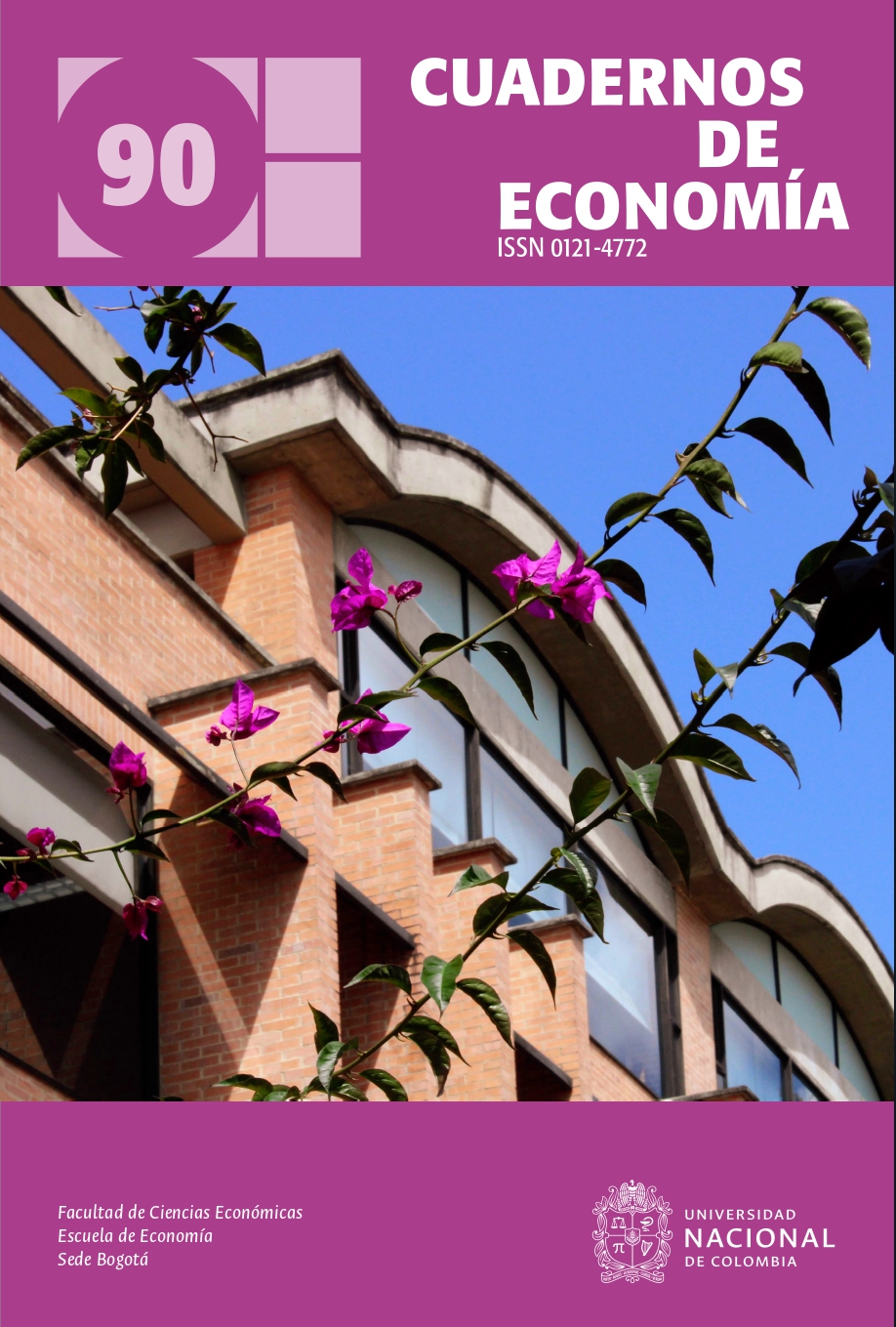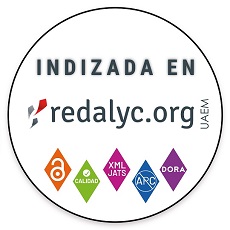Measures of Upstreamness and Downstreamness based on exports
Medición de upstreamness y downstreamness a partir de las exportaciones.
DOI:
https://doi.org/10.15446/cuad.econ.v42n90.102632Palabras clave:
Global value chains, Upstreamness, Downstreamness (en)cadenas globales de valor, upstreamness, downstreamness (es)
Descargas
In this paper I discuss and develop measures of upstreamness and downstreamness to describe the position of countries and sectors in global value chains. Both measures are defined as the distance between exports and either final demand (upstreamness) or primary factors (downstreamness). When added together, they create a single measure of chain length, and reveal the position of the chain in international trade. I show the usefulness of these measures for highlighting aspects of international participation in value chains that cannot be deduced from measures developed previously. In particular, the measures proposed here better describe the specialization of countries along value chains.
Este artículo discute y desarrolla medidas de Upstreamness y Downstreamness para describir la posición de los países y sectores en las cadenas globales de valor. Las medidas están definidas como distancia entre exportaciones y demanda final (Upstreamness) o con los factores primarios (Downstreamness) y pueden resumirse en medidas simples de largo y posición en cadenas en el comercio internacional. Estas medidas muestran aspectos de la participación en cadenas de valor que no se obtienen con las medidas de referencia. En particular, la especialización de los países a lo largo de las cadenas queda mejor reflejada con las medidas propuestas aquí.
Referencias
Ahmad, N., Araujo, S., Lo Turco, A., & Maggioni, D. (2013). Using trade microdata to improve trade in value-added measures: Proof of concept using Turkish data. In A. Mattoo, Z. Wang, & S-J Wei (Eds.), Trade in value added: Developing new measures of cross-border trade (pp.187-220). World Bank Group.
Alfaro, L., Chor, D., Antràs, P., & Conconi, P. (2019). Internalizing global value chains: A firm-level analysis. Journal of Political Economy, 127(2), 508-559. DOI: https://doi.org/10.1086/700935
Antràs, P. (2020). Conceptual aspects of global value chains. The World Bank Economic Review, 34(3), 551-574. DOI: https://doi.org/10.1093/wber/lhaa006
Antràs, P. & Chor, D. (2013). Organizing the global value chain. Econometrica, 81(6), 2127-2204. https://doi.org/10.3982/ECTA10813 DOI: https://doi.org/10.3982/ECTA10813
Antràs, P. & Chor, D. (2018). On the measurement of upstreamness and downstreamness in global value chains. In L. Y. Ing & M. Yu (Eds.), World trade evolution: Growth, productivity and employment (pp. 126-194). Routledge. DOI: https://doi.org/10.4324/9781351061544-5
Antràs, P., Chor, D., Fally, T., & Hillberry, R. (2012). Measuring the upstreamness of production and trade flows. American Economic Review, 102(3), 412-416. https://doi.org/10.1257/aer.102.3.412 DOI: https://doi.org/10.1257/aer.102.3.412
Arto, I., Dietzenbacher, E., & Rueda-Cantuche, J. M. (2019). Measuring bilateral trade in terms of value added (EUR 29751 EN). Publications Office of the European Union. https://doi.org/
Baldwin, R., Freeman, R., & Theodorakopoulos A. (2022). Horses for courses: Measuring foreign supply chain exposure (WP N30525). National Bureau of Economic Research. https://doi.org/10.3386/w30525 DOI: https://doi.org/10.3386/w30525
Bernard, A. B., Jensen, J. B., Redding, S. J., & Schott, P. K. (2007). Firms in international trade. Journal of Economic Perspectives, 21(3), 105-130. https://doi.org/10.1257/jep.21.3.105 DOI: https://doi.org/10.1257/jep.21.3.105
Borin, A., & Mancini, M. (2019). Measuring what matters in global value chains and value-added trade (Policy Research Working Paper 8804). World Bank Group. DOI: https://doi.org/10.1596/1813-9450-8804
Borin, A., Mancini, M., & Taglioni, D. (2021). Countries and sectors in global value chains (Policy Research Working Paper 9785). World Bank Group. DOI: https://doi.org/10.1596/1813-9450-9785
Chiquiar, D., & Tobal, M. (2019). Global value chains in Mexico: A historical perspective (Working Paper 2019-06). Banco de Mexico.
De Backer, K., & Miroudot, S. (2014). Mapping global value chains (Working Paper 1677). European Central Bank. DOI: https://doi.org/10.2139/ssrn.2436411
Dietzenbacher, E., & Romero, I. (2007). Production chains in an interregional framework: Identification by means of average propagation lengths. International Regional Science Review, 30(4), 362-383. DOI: https://doi.org/10.1177/0160017607305366
Dollar, D. R., Inomata, S., Degain, C., Meng, B., Wang, Z., Ahmad, N., Primi, A., Escaith, H., Engel, J., Taglioni, D., Heuser, C., Mattoo, A., Kidder, M., Ruta, M., & Reis, J. G. (2017). Global Value Chain Development Report 2017: Measuring and analyzing the impact of GVCs on economic development. International Bank for Reconstruction and Development/The World Bank.
Fally, T. (2012). Production staging: Measurement and facts. Unpublished paper, University of California, Berkeley.
Johnson, R. C. (2018). Measuring global value chains. Annual Review of Economics, 10, 207-236. https://doi.org/10.3386/w24027 DOI: https://doi.org/10.1146/annurev-economics-080217-053600
Johnson, R. C., & Noguera, G. (2012). Accounting for intermediates: Production sharing and trade in value added. Journal of international Economics, 86(2), 224-236. https://doi.org/10.1016/j.jinteco.2011.10.003 DOI: https://doi.org/10.1016/j.jinteco.2011.10.003
Knez, K., Jaklic, A., & Stare, M. (2021). An extended approach to value chain analysis. Journal of Economic Structures, 10(1), 1-37. https://doi.org/10.1186/s40008-021-00244-6 DOI: https://doi.org/10.1186/s40008-021-00244-6
Koopman, R., Wang, Z., & Wei, S.-J. (2014). Tracing value-added and double counting in gross exports. American Economic Review, 104(2), 459-494. https://doi.org/10.1257/aer.104.2.459 DOI: https://doi.org/10.1257/aer.104.2.459
Los, B. & Timmer, M. P. (2020). Measuring bilateral exports of value added: A unified framework. In N. Ahmad, B. R. Moulton, J. D. Richardson, & P. van de Ven (Eds.), The challenges of globalization in the measurement of national accounts (pp. 389-421). University of Chicago Press.
Los, B., Timmer, M. P., & de Vries, G. J. (2015). How global are global value chains? A new approach to measure international fragmentation. Journal of Regional Science, 55(1), 66–92. https://doi.org/10.1111/jors.12121 DOI: https://doi.org/10.1111/jors.12121
Los, B., Timmer, M. P., & de Vries, G. J. (2016). Tracing value-added and double counting in gross exports: Comment. American Economic Review, 106(7), 1958-1966. https://doi.org/10.1257/aer.20140883 DOI: https://doi.org/10.1257/aer.20140883
Miller, R. E., & Temurshoev, U. (2017). Output upstreamness and input downstreamness of industries/countries in world production. International Regional Science Review, 40(5), 443-475. https://doi.org/10.1177/01600176156080 DOI: https://doi.org/10.1177/0160017615608095
Nagengast, A. J., & Stehrer, R. (2016). Accounting for the differences between gross and value added trade balances. The World Economy, 39(9), 1276-1306. https://doi.org/10.1111/twec.12401 DOI: https://doi.org/10.1111/twec.12401
Reshef, A., & Santoni, G. (2022). are your labor shares set in Beijing? The view through the lens of global value chains (Working Paper 9835). CESifo. https://www.cesifo.org/en/publications/2022/working-paper/are-your-labor-shares-set-beijing-view-through-lens-global-value DOI: https://doi.org/10.2139/ssrn.4163324
Puzzello, L. (2012). A proportionality assumption and measurement biases in the factor content of trade. Journal of International Economics, 87(1), 105-111. https://doi.org/10.1016/j.jinteco.2011.11.009 DOI: https://doi.org/10.1016/j.jinteco.2011.11.009
Sanguinetti, P., Moncarz, P., Vaillant, M., Allub, L., Juncosa, F., Barril, D., & Lalanne, Á. (2021). Participación en cadenas de valor. In CAF (Ed.), RED 2021 – Caminos para la integración: facilitación de comercio, infraestructura y cadenas globales de valor (pp. 273-312). CAF. https://scioteca.caf.com/handle/123456789/1823
Wang, Z., Wei, S.-J., & Zhu, K. (2013). Quantifying international production sharing at the bilateral and sector levels (Working paper 19677). National Bureau of Economic Research. DOI: https://doi.org/10.3386/w19677
Wang, Z., Wei, S.-J., Yu, X., & Zhu, K. (2017a). Characterizing global value chains: Production length and upstreamness (Working Paper 23261). National Bureau of Economic Research. DOI: https://doi.org/10.3386/w23261
Wang, Z., Wei, S.-J., Yu, X., & Zhu, K. (2017b). Measures of participation in global value chains and global business cycles (Working Paper 23222). National Bureau of Economic Research. DOI: https://doi.org/10.3386/w23222
World Bank. (2019). World Development Report 2020: Trading for Development in the Age of Global Value Chains. World Bank Publications.
Xing, Y., Gentile E., & Dollar., D. (Eds.) (2021). Global Value Chain Development Report 2021: Beyond Production. Asian Development Bank, Research Institute for Global Value Chains at the University of International Business and Economics, the World Trade Organization, the Institute of Developing Economies – Japan External Trade Organization, China Development Research Foundation.
Cómo citar
APA
ACM
ACS
ABNT
Chicago
Harvard
IEEE
MLA
Turabian
Vancouver
Descargar cita
CrossRef Cited-by
1. Siying Zhao, Fengshi Jing, Zi'Ang Wang, Jin Huang. (2024). Predicting Supply Chain Upstreamness Using An Ensemble Machine Learning Method. 2024 12th International Conference on Traffic and Logistic Engineering (ICTLE). , p.28. https://doi.org/10.1109/ICTLE62418.2024.10703963.
Dimensions
PlumX
Visitas a la página del resumen del artículo
Descargas
Licencia
Derechos de autor 2023 Cuadernos de Economía

Esta obra está bajo una licencia internacional Creative Commons Atribución-NoComercial-SinDerivadas 4.0.
Cuadernos de Economía a través de la División de Bibliotecas de la Universidad Nacional de Colombia promueve y garantiza el acceso abierto de todos sus contenidos. Los artículos publicados por la revista se encuentran disponibles globalmente con acceso abierto y licenciados bajo los términos de Creative Commons Atribución-No_Comercial-Sin_Derivadas 4.0 Internacional (CC BY-NC-ND 4.0), lo que implica lo siguiente:





















